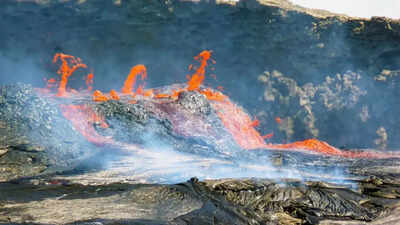East Africa's Rift Valley: A New Ocean Emerges from Earth's Mantle
In the Afar Depression of East Africa, a unique geological hotspot where three tectonic plates converge, scientists have uncovered compelling evidence of a continent gradually splitting apart. This process, driven by the upwelling of fresh lava from deep within the Earth's mantle, is paving the way for the birth of a new ocean.
 *Volcanic activity reshaping the landscape in East Africa's Afar region.*
*Volcanic activity reshaping the landscape in East Africa's Afar region.*
Recent research indicates that the mantle upwellings beneath this region are not uniform. Instead, they manifest as complex pulses of molten material, triggering volcanic eruptions and seismic activity, while simultaneously weakening the Earth's crust. This geological activity is expected to eventually separate the Horn of Africa from the rest of the continent, creating a new ocean basin.
Unveiling Earth's Inner Workings Through Lava Analysis
Researchers from the University of Southampton and Swansea University conducted a comprehensive analysis of lava samples collected from over 130 young volcanoes throughout the Afar region. Their findings revealed that the mantle beneath East Africa exhibits a rhythmic behavior, with pulses of partially molten rock surging towards the surface.
Each pulse possesses a unique chemical signature, suggesting that the mantle is composed of a diverse array of materials rather than a single, homogenous plume. The thickness and movement of the overlying tectonic plates significantly influence this dynamic behavior.
In regions with rapid rifting, such as the Red Sea Rift, the mantle flow is more focused and intense. Conversely, in areas with slower rifting, the flow spreads out more gradually. These pulses ascend through thinned areas of the Earth's crust, making them more prone to volcanic eruptions.
The chemical variations observed in the lava resemble cardiovascular rhythms, reflecting the Earth's deep internal tempo. This provides valuable insight into the connection between volcanic activity on the surface and the hidden processes occurring far below.
The plume's activity is also thinning the lithosphere, Earth's outer shell, to a mere 15 kilometers in certain areas of the Afar Depression. As the plates continue to stretch and thin, they create pathways for increased lava flow to the surface, resulting in recurring cycles of volcanic eruptions and seismic activity. This process mirrors the geological events that led to the formation of the Atlantic Ocean millions of years ago.
Continental Rifting: The Birth of a New Ocean
The geological activity in the Afar region is part of a broader phenomenon known as continental rifting, where the African, Arabian, and Somali tectonic plates are gradually moving apart. The resulting space is filled with rising magma and newly formed crust. As this rifting progresses, seawater is expected to inundate the region, permanently creating a new ocean basin, similar to the Atlantic Ocean that separated Europe and North America.
The current volcanic activity is already transforming the landscape. Lava flows from the Erta Ale volcano have blanketed vast areas of Ethiopia, and frequent earthquake swarms indicate zones of intense tectonic stress. The Boset Volcano displays numerous layers of volcanic deposits, illustrating the long-term accumulation of geological events driven by the mantle's upwelling.
These findings offer a unique opportunity to observe the birth of an ocean in real-time. They also have implications for understanding Earth's climate history. Similar mantle plumes in the past have generated massive volcanic provinces, such as the North Atlantic Igneous Province, which contributed to significant climate changes and potentially even mass extinctions due to the release of CO₂ and sulfur dioxide.
Scientists emphasize the importance of collaboration across institutions and disciplines to fully understand these complex dynamics. Future research will focus on mapping mantle flows beneath other thinning tectonic plates and predicting how these deep forces shape surface geology. The Afar region serves as a natural laboratory for studying the connection between Earth's interior and its evolving surface.
Older articles
 Gavaskar Urges India to Replace Thakur with Yadav for Second Test Against England
Gavaskar Urges India to Replace Thakur with Yadav for Second Test Against England
 Rishabh Pant's Unconventional Batting Style Is Revolutionizing Cricket, Says Greg Chappell
Rishabh Pant's Unconventional Batting Style Is Revolutionizing Cricket, Says Greg Chappell
 Google Maps Boosts Navigation Precision with Fused Orientation Provider Update
Google Maps Boosts Navigation Precision with Fused Orientation Provider Update
 Colon Cancer: Don't Ignore These 5 Subtle Warning Signs
Colon Cancer: Don't Ignore These 5 Subtle Warning Signs
 Sachin Tendulkar: 1983 World Cup Triumph Ignited My Cricket Dream at Age 10
Sachin Tendulkar: 1983 World Cup Triumph Ignited My Cricket Dream at Age 10
 ICC Test Rankings: Pant Hits Career-High, Bumrah Retains Top Spot, Root Still Leads Batters
ICC Test Rankings: Pant Hits Career-High, Bumrah Retains Top Spot, Root Still Leads Batters
 India's Eeriest Destinations: Unveiling the Top 8 Haunted Sites and Their Spooky Backstories
India's Eeriest Destinations: Unveiling the Top 8 Haunted Sites and Their Spooky Backstories
 India's Harshit Rana Released from Squad Ahead of Second Test Against England
India's Harshit Rana Released from Squad Ahead of Second Test Against England
 Australia vs India: Cricket Fans Snap Up Tickets as Series Sells Out Months in Advance
Australia vs India: Cricket Fans Snap Up Tickets as Series Sells Out Months in Advance
 Boost Your Vision: 7 Top Foods for Healthy Eyesight
Boost Your Vision: 7 Top Foods for Healthy Eyesight